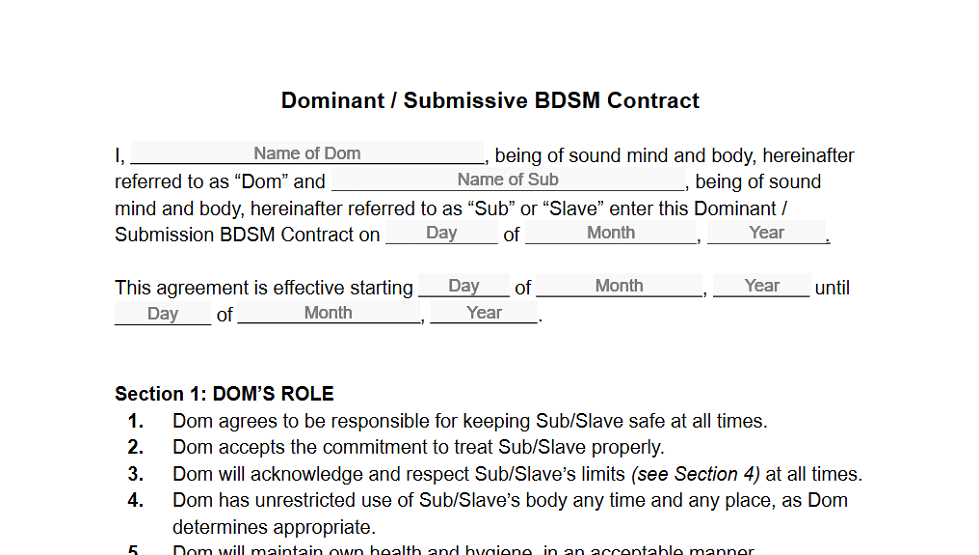Fillable Form Dominant Submissive Contract
This form serves as an agreement which defines in specific terms the power exchange relationship and interaction between two individuals, hereafter termed the submissive and the Dominant. This agreement is only binding between the two people signed below. This agreement is entered voluntarily with both parties agreeing to the conditions.
Fill and sign Dominant Submissive Contract online and download in PDF.
What is a Dominant-Submissive BDSM Contract?
A Dominant-Submissive BDSM Contract is an agreement entered by a Dominant (a Dom, or sometimes Domme in the case of a female Dom) and a Submissive (Sub, or sometimes called a Slave in the context of certain kinds of BDSM relationships) in order to establish the terms and conditions that apply to their relationship. BDSM contracts often contain information regarding what the Dom or the Sub consider to be acceptable boundaries and actions within their relationship, and the mechanisms that the Sub may use to inform the Dom that they wish to stop an activity or end the relationship entirely.
BDSM stands for Bondage and Discipline (BD), Dominance and Submission (DS), and Sadism and Masochism (SM). BDSM-related activities are often colloquially referred to as kink or play, and people who engage in them generally identify themselves as being part of the BDSM or Kink community. Kink, in most cases, is often heavily associated with sexual activity, though it need not necessarily be sexual in nature or practice and instead be more focused on the power exchange and the concept of trust and being able to safely entrust yourself to someone else.
It is important to remember that BDSM relationships (and by extension any agreements involved in them such as this contract) are heavily based on trust, and as such people who engage in or wish to engage in such relationships and activities are heavily encouraged even by people within the community to have, at minimum, a “Safe Word” - a word that signals to the Dom that the Sub wishes for whatever is being done to them to stop immediately and without question.
A key part of BDSM relationships is the ability of both parties to provide their consent and withdraw it at any time. For this reason, dominant submissive contracts are drafted and signed in order to ensure that both parties are not only aware of the terms of the relationship, but also are providing their consent as well as a way to withdraw said consent should they feel it is necessary. Dominant-submissive BDSM contracts and relationships’ “goal” is, ultimately, for both parties to experience mutual pleasure in engaging in BDSM play, for which consent is considered a requirement under all circumstances.
Despite what they are called, BDSM contracts are not legally binding. They are simply a way for both parties to understand what is expected of them throughout the course of the relationship. It is instead a morally binding contract that primarily has value within the BDSM community but nowhere else, similar to a sort of honor system where the community expects that a contract between a Dom and a Sub should be followed by both parties unless and until one decides to terminate the agreement.
A BDSM contract may be enforced and remain valid for as long as the parties involved wish it to be - though it is often the Sub that is the deciding factor on whether or not the contract should be honored or not, to the point that in some cases it can be said that it is the Sub that actually controls the relationship, as opposed to the Dom. Even should there be terms that restrict a Sub’s ability to leave the relationship or otherwise terminate the contract, said terms will never actually be legally binding, and the Sub may actually leave any time he or she wishes.
Who needs to use a Dominant-Submissive BDSM Contract?
A Dominant-Submissive BDSM Contract is used by Doms and Subs who wish to negotiate the terms of their relationships and BDSM play with each other, often before engaging in any such play or after only one session so that both parties can be aware of how the BDSM play will be practiced.
There are several different, possible forms of a BDSM contract, and even this form may require some additions and alterations to be made depending on the terms set by the Dom and the Sub.
How to fill out a Dominant-Submissive BDSM Contract?
Get a copy of Dominant Submissive Contract template in PDF format.
Get the fillable Dominant Submissive Contract from PDFRun.
It is vitally important that both the Dom and the Sub have thoroughly read and understood all terms in the agreement. Trust and consent are the backbone of all BDSM relationships and contracts, and so both parties must be fully aware of what they are agreeing to even if the contract is not legally binding.
Section 0: Contract Information
This section entails the names of the Dom and Sub, and the effective dates of the contract.
-
Name of Dom
Enter the Dom’s full name.
-
Name of Sub
Enter the Sub’s full name.
-
Date of Agreement
Enter the date that the contract was drafted and signed.
-
Period of Agreement
Enter the date that the contract will start and the date when the contract will “end” or otherwise be renegotiated (barring extreme circumstances).
Section 1: Dom’s Role
This section outlines what the Sub is, by signing the contract, allowing the Dom to do to them (and their body). This includes when, where, how, and why the Dom may engage in BDSM play with their Sub. This section also outlines the responsibilities the Dom agrees to by signing the contract as part of their care for both themselves and their Sub, such as agreeing to keep their hygiene and health in good condition at all times, or ensuring that the Sub is properly trained in such a way that they are able to carry out their role as stated in the contract to the Dom’s satisfaction.
These terms can be negotiated and some of them may be removed or added depending on what the Sub and the Dom agree on as a good list of responsibilities for the Dom. Note that, as with most terms on this contract, this can be renegotiated or amended at another time should it be necessary.
Section 2: Sub/Slave’s Role
This section details the expectations and responsibilities that the Sub agrees to be subjected to upon signing the contract. This includes where, when, how, and why the Dom may engage the Sub in BDSM play, when they will use their Safe Word, and et cetera.
Similar to the Dom’s Role as outlined above, the terms in this section may be negotiated, renegotiated, and amended at another time should it be necessary.
Section 3: Safety and Safe Words
This section concerns the confidentiality of this agreement, and the words that will be assigned as the Sub’s Safe Words for the relationship.
The Sub should in the spaces provided, enter the following:
- A word that signals the Dom to immediately stop what they are doing as the Sub is in distress or otherwise may not be able to endure more.
- A word that signals to the Dom that the Sub is almost at their limit but does not want the Dom to stop what they are doing.
Note that the Safe Words should be words that are very easily recognizable, and would not be used even in the heat of passion.
This section also outlines the reasons for which the Sub may refuse to follow an order from their Dom, which include:
- The order conflicts with existing laws
- The order endangers the Sub’s life
- The order may cause permanent Bodily Harm (as defined in Section 1, Dom’s Role)
- The order may cause psychological trauma
Section 4: Limits
This section outlines the Hard and Soft limits of both the Dom and the Sub - in other words, what the Dom and the Sub have restrictions on doing or refuse to do outright.
-
For Dom
-
Hard Limits
-
Enter what acts or kinks the Dom absolutely refuses to practice in the space provided. Make sure that the list is comprehensive in order to ensure that the Dom’s hard limits are clear to the Sub.
-
Soft Limits
Enter what acts or kinks the Dom is willing to engage in, but only under strict conditions and restrictions. Make sure that the list is comprehensive in order to ensure that the Dom’s soft limits and the restrictions surrounding them are clear to the Sub.
-
For Sub/Slave
-
Hard Limits
-
Enter what acts or kinks the Sub absolutely refuses to practice in the space provided. Make sure that the list is comprehensive in order to ensure that the Sub’s hard limits are clear to the Dom as well.
-
Soft Limits
Enter what acts of kinks the Sub is willing to engage in, but only under strict conditions and restrictions. Make sure that the list is comprehensive in order to ensure that the Sub’s soft limits and the restrictions surrounding them are clear to the Dom.
Section 5: Agreement
This section outlines the Hard and Soft limits of both the Dom and the Sub - in other words, what the Dom and the Sub have restrictions on doing or refuse to do outright.
Tips when filling out a Dominant-Submissive BDSM Contract
BDSM contracts are not legally binding. Therefore, it is important to make sure that you trust the person you are entering into such a relationship with, and that you make all information regarding the terms on the contract and your hard and soft limits clear.
- Keep a copy of the contract in a safe place. This will be useful as a record of the original agreement, and be important should you wish to renegotiate the terms in the contract in the future.
- Remember that the contract is not legally binding. Despite being called a contract, there is no actual legal value to the agreement. A BDSM contract is valid only for as long as the Dom and the Sub wish for it to be.
- Remember the Safe Words and which one is which. It is very important that both parties remember the Safe Words as indicated on the contract, to ensure safe and fully consensual BDSM play.
Create a Dominant Submissive Contract document, e-sign, and download as PDF.
Don't have a partner yet? Try this fun way to look for potential partners.
Keywords: dominant submissive contract sub dom contract dominant submissiveness bdsm contract bdsm contract



















